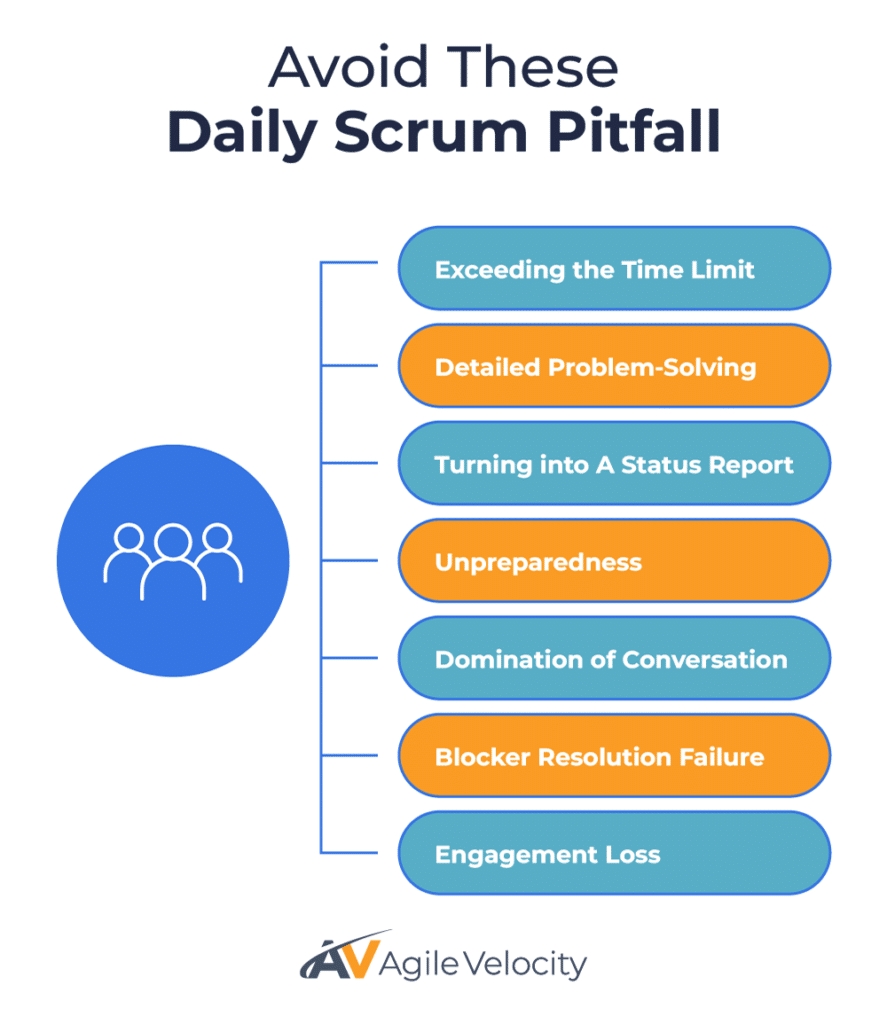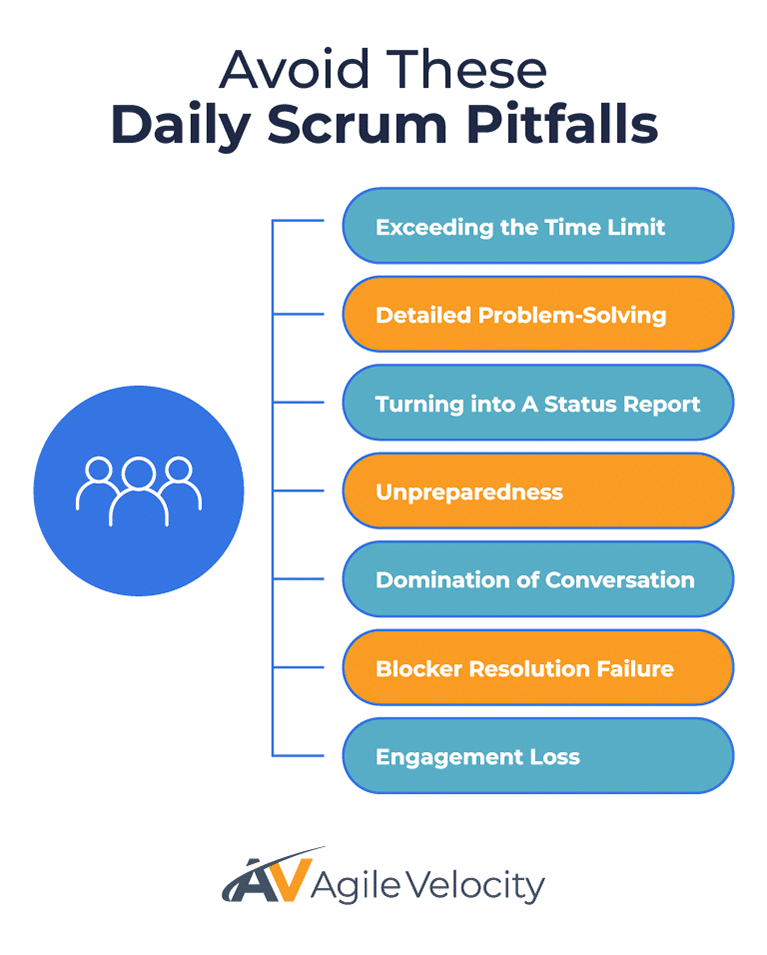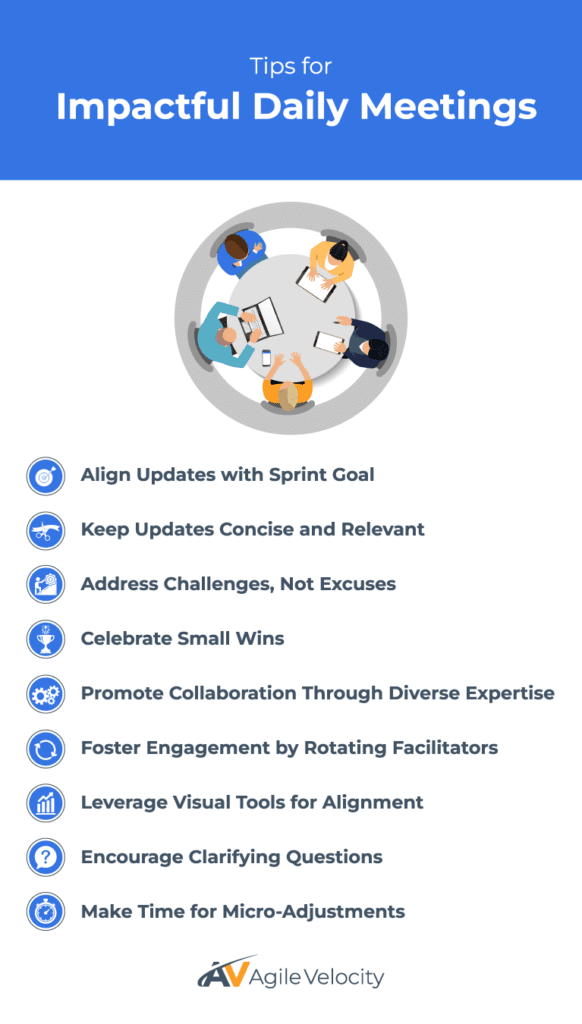In the Scrum Agile framework, clear communication and collaboration are essential for achieving team goals, and at the heart of this is the Daily Scrum. This short yet impactful event serves as a daily alignment tool that helps teams track progress, identify challenges, and coordinate their efforts toward the Sprint Goal. While the concept of the Daily Scrum may sound simple, many teams struggle to unlock its full potential, often reducing it to a routine chore instead of a productivity-boosting event.
In this guide, we’ll explore actionable tips and proven strategies to transform your team’s Daily Scrum into an engaging, results-driven session. From structuring the event effectively to avoiding common pitfalls, you’ll learn how to fully utilize this synchronization opportunity.
Embrace these practices, and your team will not only make the most of every Daily Scrum but also strengthen its ability to achieve long-term Agile success.
What is the Daily Scrum?
The Daily Scrum (stand-up, huddle, daily sync and other names) is a short, focused event that serves as the backbone of daily team alignment within the Agile framework. Although we are talking about the Daily Scrum in the context of the Scrum framework, it is just as valuable to teams using other frameworks such as Kanban. In fact, daily meetings like this can be very valuable for any team doing any type of work, the principles and practices all apply.
Designed to maintain transparency, identify roadblocks, and synchronize efforts, it provides the Scrum Team with an opportunity to recalibrate and plan their work. Time-boxed to 15 minutes, its purpose is to ensure progress toward the Sprint Goal remains steady while fostering collaboration and problem-solving.
While its structure may seem straightforward, the Daily Scrum offers much more than a routine check-in. It’s a powerful tool that keeps the team working in harmony, enabling quick course corrections and reinforcing accountability. Teams that master the Daily Scrum often find it to be the single most effective method for staying on target during a Sprint.
Avoiding Overlap Between Scrum Events
Each Scrum event serves a distinct purpose, and maintaining clear boundaries ensures smooth Agile processes.
- Sprint Planning: Determines Sprint work and creates an actionable plan aligning with the Sprint Goal.
- Daily Scrum: Day-to-day alignment focusing on progress toward the Sprint Goal—no long-term planning or stakeholder reviews.
- Sprint Review: Showcases deliverables, gathers feedback, and assesses Product Backlog progress.
- Sprint Retrospective: Reflects on team processes and performance to identify improvement opportunities.
Keeping these events distinct prevents redundancy, ensuring each session is focused and effective.
Why Is the Daily Scrum Important?
Daily Scrum plays a crucial role in maintaining team alignment and momentum within Agile workflows. This brief yet powerful meeting fosters transparency, allows for quick identification and resolution of obstacles, and ensures the Scrum Team’s collective focus remains on achieving the Sprint Goal effectively. By incorporating this practice, teams can enhance communication, boost accountability, and drive continuous improvement.
The Daily Scrum brings several key benefits to Agile teams:
- Aligning Around the Sprint Goal: Ensures the team remains focused on shared objectives, avoiding misaligned priorities.
- Promoting Transparency: Prevents siloed communication and unidentified roadblocks through open discussions.
- Fostering Accountability: Cultivates a culture of ownership by having team members share updates directly.
- Accelerating Agile Success: Improves delivery efficiency and sustains momentum during Agile Transformation.
When effectively facilitated, the Daily Scrum reinforces trust, boosts collaboration, and energizes the Scrum Team.
Build High-Performing Teams
Key Objectives of a Daily Scrum
Understanding the core goals of the Daily Scrum is essential for maximizing its effectiveness within Agile teams. This critical component emphasizes team alignment, transparency, and accountability, all while ensuring continuous progress toward the Sprint Goal. A well-run Daily Scrum keeps the team aligned and on track while reinforcing collaboration and accountability. Here are the primary goals every Daily Scrum should aim to achieve:
Keeping the Sprint Goal Front and Center
The Daily Scrum ensures all efforts align with the Sprint Goal, maintaining clarity on what success looks like by the Sprint’s end. By revisiting the Sprint Goal daily, the team reinforces its purpose and focuses on delivering value.
Surfacing and Addressing Blockers Early
Identifying impediments before they disrupt progress is a key advantage of the Daily Scrum. Common blockers, such as unresolved dependencies or conflicting priorities, can derail the team if left unaddressed. The Scrum Master facilitates follow-up actions to resolve these promptly, maintaining steady momentum.
Synchronizing Team Efforts
The Daily Scrum provides a platform for the team to align their work for the next 24 hours. Each member shares what they achieved yesterday, their current focus, and any blockers. It also helps the team understand what work remains toward goals and rebalance workloads in almost real-time. This collective planning reduces overlap and miscommunication, increasing efficiency toward the Sprint Goal.
Driving Incremental Improvement
Continuous improvement is a hallmark of Agile teams, and the Daily Scrum highlights recurring challenges or process inefficiencies that can be addressed in Sprint Retrospectives. This fosters small, consistent adjustments driven and implemented by the team that lead to meaningful improvements over time.
By focusing on these objectives, the Daily Scrum becomes a strategic opportunity that empowers teams to work smarter, adapt faster, and deliver greater value.
Setting the Foundation for Effective Daily Scrums
An effective Daily Scrum requires a solid foundation. Without the right groundwork, this vital Agile event can lose direction or become unproductive. By prioritizing essential elements such as clear goals, defined roles, and a culture of openness, Agile Teams can create conditions necessary for a focused and value-driven Daily Scrum.


Establish a Clear Sprint Goal
A successful Daily Scrum hinges on a clear Sprint Goal set during Sprint Planning. This shared objective ensures all discussions during the Daily Scrum are aligned with delivering value. Without a clear goal, the event risks becoming a disconnected update session. A cohesive Sprint Goal serves as the team’s guiding compass, keeping efforts on track and driving purposeful contributions.
Clarify Roles Within the Scrum Team
A successful Daily Scrum is a team effort, with each role contributing to its effectiveness. While everyone in the Scrum Team participates, their contributions differ based on their responsibilities.
Scrum Master: The Facilitator and Guide
The Scrum Master fosters a productive and collaborative Daily Scrum by:
- Guarding Time and Focus: Ensures the Daily Scrum stays within the allotted time-frame and aligns with its purpose.
- Encouraging Participation: Creates a safe environment for all team members to share updates and challenges.
- Addressing Blockers Beyond the Scrum: Identifies who can resolve impediments and coordinates follow-up actions outside the session.
- Reinforcing Agile Principles: Coaches the team on Agile best practices to build better habits over time.
- Encouraging Specifics: It is critical that each team member talk in specifics about their work rather than generalities. “I’m working on X” is generally a red flag.
Product Owner: The Visionary and Clarifier
The Product Owner adds clarity and alignment without dominating the Daily Scrum by:
- Resource for the Team: While the Product Owner does not have a speaking role during this meeting, they need to be present and ready to help when the team needs it.
- Ensuring Clarity around Priorities: Helps the team understand how tasks align with the Product Backlog and Sprint Goal.
- Offering Feedback, Not Directing Work: Advises and clarifies without micromanaging the conversation.
- Providing Inputs on Changing Requirements: Updates the team on new demands or shifts in priorities without disrupting the flow.
Scrum Team Members: The Collaborators and Problem Solvers
Developers and team members share progress, identify blockers, and align efforts by:
- Sharing Concise Updates: Answering what was accomplished yesterday, what’s planned today, and any blockers.
- Collaborating with Peers: Supporting each other to overcome challenges and properly align tasks with Sprint Goal.
- Taking Ownership of Progress: Actively owning their contributions to ensure transparency and accountability.
Understanding and fulfilling these roles ensures the Scrum Team strengthens communication, trust, and shared accountability, creating a cohesive and high-performing team.
Foster a Culture of Open Communication
Encourage an atmosphere of trust where obstacles can be highlighted and addressed proactively. When team members feel safe to share progress and challenges, the session becomes a forum for authentic collaboration. This openness enhances team cohesion and enables timely problem-solving.
Maintain a Consistent Schedule and Location
Consistency builds an effective routine. Whether in-person or remote, establish a specific time and method for the Daily Scrum. A regular schedule, such as 9:00 a.m. daily, helps form a reliable habit, improving attendance and readiness. A consistent format reduces confusion, minimizes disruptions, and fosters a stronger rhythm for effective communication.
By setting these foundational elements, teams ensure their Daily Scrum is productive and seamlessly integrated into their Agile workflow.
Structuring a Daily Scrum for Maximum Value

A well-structured Daily Scrum is key to maximizing its value, ensuring it remains engaging and productive. While the classic format of discussing what was done yesterday, what will be done today, and blockers works for many teams, some prefer tailored approaches that better align with their workflows. Regardless of the format, maintaining clarity, focus, and flow is essential to unlock maximum value.
Keep It Time-Boxed
The Daily Scrum is designed to be short and impactful, with a recommended 15-minute time-box. This constraint keeps the session focused and ensures only the most relevant updates are shared. Assign a timekeeper to monitor the clock, and take in-depth issues offline to maintain momentum.
Leverage Visual Aids
Incorporate visual tools like Task Boards as shared reference points. “Walking the board” allows the team to review ongoing tasks, identify progress, and spot bottlenecks systematically. Use color-coded tags or prioritize tasks nearing completion to streamline communication and reduce misunderstandings.
Focus on Actionable Updates
Encourage updates directly relevant to advancing work toward the Sprint Goal. Skip granular details and lengthy explanations; instead, cover immediate priorities, blockers, and opportunities for collaboration. Note complex topics for follow-up discussions outside the session.
Rotate Facilitation
While the Scrum Master typically facilitates the Daily Scrum, occasionally rotating this responsibility among team members can enrich engagement and build ownership. This allows individuals to experience the event from different perspectives, promoting broader accountability and fresh ideas. Teams that are good at the Daily Scrum frequently end up with no facilitator as they know exactly what needs to happen.
Incorporate Gamification for a Boost of Fun
Introduce light gamification elements like small tokens or badges to create a sense of accomplishment and keep participants motivated.
Encourage Thoughtful Questions
Promote a culture of inquisitiveness by encouraging team members to ask clarifying or relevant questions during the Scrum.
Highlight and Celebrate Small Wins
Recognize and celebrate progress to maintain a positive atmosphere and reinforce the team’s efforts.
Refresh the Format Periodically
Introduce variations such as focus questions or different update formats to prevent monotony and keep the session engaging.
By structuring the Daily Scrum with clear boundaries, collaborative tools, and purposeful updates, teams ensure it remains a valuable pillar of their Agile practices.
Common Pitfalls and How to Overcome Them
Despite its straightforward nature, the Daily Scrum can sometimes go off track, leading to frustration or failure to achieve its intended value. Here are common pitfalls and solutions to address them:


Exceeding the Time Limit
Allowing the Daily Scrum to extend beyond 15 minutes can cause loss of focus and disengagement.
Solution:
- Assign a timekeeper to enforce the time-box.
- Encourage concise updates relevant to the Sprint Goal.
- Table detailed discussions for follow-ups after the session.
Diving into Detailed Problem-Solving
Transforming the Daily Scrum into a problem-solving session derails its purpose.
Solution:
- Acknowledge deeper issues and assign action items or schedule breakout sessions for further discussion.
- Remind the team that the focus is on alignment and identifying obstacles, not resolving them in the event.
Turning It into a Status Report
Treating the Daily Scrum as a status update for the Scrum Master or Product Owner shifts focus from team collaboration.
Solution:
- Encourage team members to speak to each other rather than to the Scrum Master or Product Owner.
- Reinforce that the event is owned by the Scrum Team, not the facilitator.
Showing Up Unprepared
Lack of preparation can lead to vague updates and prolonged pauses, wasting time and diminishing impact.
Solution:
- Encourage team members to reflect on three key questions in advance:
- What did I accomplish yesterday?
- What will I accomplish today?
- What challenges am I facing?
- The mental shift from “working on” to “accomplishments or completed” can be tough and it may take a while for this to become the team’s way of thinking.
- Promote readiness as essential for the team’s success.
Allowing One Person to Dominate the Conversation
When one or two individuals dominate, others may disengage, reducing collaborative value.
Solution:
- Rotate the speaking order regularly to ensure equitable participation.
- The Scrum Master (ideally other team members do this without prompt) should gently steer the conversation to invite quieter members to share their updates.
Failing to Address Blockers Effectively
Unresolved blockers undermine the Daily Scrum’s credibility and to deliver everything in their plan.
Solution:
- Ensure that a team member accepts clear ownership for each identified blocker to resolve outside the session.
- Raise the blocker everyday
Losing Engagement Over Time
Repetition can lead to complacency, making the Daily Scrum feel like a mundane check-in.
Solution:
- Rotate facilitators or introduce small variations to keep the team engaged.
- Celebrate small wins or milestones during the session.
- Revisit and reinforce the purpose of the Daily Scrum regularly to maintain motivation.
By recognizing and addressing these common pitfalls, teams can transform their Daily Scrums into effective and focused sessions.
Embracing Hybrid Team Environments
Many organizations operate in hybrid or remote settings, introducing logistical challenges to Daily Scrums. Adapting practices to fit hybrid teams ensures the effectiveness and value of this essential Agile event.
Navigating Time Zone Differences
- Rotate Event Times: Alternate Daily Scrum times to accommodate different time zones fairly.
- Asynchronous Updates: Allow remote members to provide updates via collaboration tools.
- Keep it Concise: Respect schedules by adhering to the time-box.
Leverage the Right Collaboration Tools
- Utilize Video Conferencing: Foster connection with cameras on in order to enhance engagement.
- Adopt Visual Collaboration Tools: Use virtual boards or dashboards as shared references.
- Integrate Instant Messaging and Updates:Maintain continuous communication through digital tools.
Adjust Formats for Inclusivity
- Create a Unified Experience: Ensure both in-person and remote members participate equally.
- Turn Remote Limitations into Strengths: Use centralized documentation and tracking for all team members.
- Include Opportunities for Energy-Building: Engage remote participants with acknowledgments and inclusive practices.
Though hybrid environments present unique challenges, businesses can maintain the Daily Scrum’s value by adapting scheduling, technology, and team dynamics thoughtfully.
The Importance of Psychological Safety in Daily Scrums
Psychological safety is crucial for maximizing the value of your Daily Scrums. When team members feel safe to express opinions, admit challenges, and ask for help without fear of judgment, they contribute more authentically, fostering trust, collaboration, and innovation.
Encouraging Honest Communication
Open communication ensures updates reflect true progress and challenges, allowing for collective problem-solving and alignment toward the Sprint Goal.
Promoting Experimentation and Learning
Encourage team members to take on work outside their usual domain or skill set, try new methods and suggest changes, fostering a culture of adaptability and continuous improvement.
Strengthening Team Collaboration and Trust
Psychological safety strengthens team bonds, encouraging mutual respect and empathy, which enhances day-to-day efforts and long-term cohesion.
By cultivating psychological safety, teams enable open communication, foster a learning culture, and build stronger collaborative relationships, driving better outcomes and team growth.
Practical Tips to Enhance Productivity During Daily Scrums
To maximize the value of your Daily Scrums, consider implementing these practical tips that focus on boosting team productivity and engagement. These strategies are designed to fine-tune your efforts, ensuring each session contributes effectively toward achieving the Sprint Goal. By adopting proven techniques and embracing an adaptive approach, your team can navigate common challenges, streamline processes, and drive meaningful progress on a daily basis.
Transform your Daily Scrum into a highly productive session with these key tips:


Align Updates with the Sprint Goal
Tie updates directly to the Sprint Goal to keep discussions relevant and maintain clarity on team objectives. This ensures conversations are purposeful and contribute to delivering value.
Keep Updates Concise and Relevant
Encourage brief updates focused on accomplishments, plans, and blockers. Avoid lengthy explanations and detailed tasks, which can derail the session’s focus.
Address Challenges, Not Excuses
Encourage members to share blockers constructively, framing them in terms of actionable steps rather than excuses. This fosters a problem-solving environment.
Celebrate Small Wins
Acknowledge and celebrate progress to maintain a positive atmosphere and boost team morale. Recognition of small achievements reinforces a culture of success.
Promote Collaboration Through Diverse Expertise
Encourage team members with different skills to offer insights and support each other. Cross-functional collaboration enhances problem-solving and efficiency.
Foster Engagement by Rotating Facilitators
Rotate the facilitator role among team members to increase engagement and ownership. This promotes different perspectives and keeps the session dynamic.
Leverage Visual Tools for Alignment
Use visual aids like task boards or dashboards to streamline communication and ensure everyone is aligned on priorities and progress.
Encourage Clarifying Questions
Foster a culture where team members feel comfortable asking brief, clarifying questions to ensure alignment and uncover new opportunities for assistance.
Make Time for Micro-Adjustments
Introduce small variations like focus questions or rotating speaking orders to keep the session fresh and prevent monotony.
By implementing these practical tips, your Scrum Team can elevate the Daily Scrum from a basic alignment event to an impactful driver of progress and collaboration.
Leveraging Path to Agility® Navigator
Achieving Agile success requires the right blend of mindset, processes, and tools. Path to Agility Navigator enhances Agile Transformation by visualizing progress, addressing recurring blockers, and identifying long-term improvement opportunities. This tool complements Daily Scrums by providing insights that help teams stay focused on immediate objectives and organizational growth.
How Path to Agility Navigator Elevates the Value of Daily Scrums
Path to Agility Navigator aligns with the purpose of Daily Scrums by offering:
- Tracking Blockers Over Time: Recognizes patterns in recurring issues, enabling teams to address root causes during Sprint Retrospectives.
- Visualizing Team Progress: Highlights progress toward goals, helping celebrate wins and identify areas for improvement.
- Establishing Next Steps for continuous improvement: Provides actionable insights to refine workflows, reduce inefficiencies, and support scalable success.
While Daily Scrums address near-term tasks, Path to Agility Navigator offers a data-driven view of organizational trends and progress. Integrating this tool allows teams to link daily alignment with broader strategies, ensuring sustained growth and continuous improvement.
Continuous Improvement Beyond the Daily Scrum
The Daily Scrum is an essential part of Agile practices, but it’s just the first step in fostering a culture of continuous improvement. Thriving Agile Teams leverage insights from Daily Scrums to drive long-term performance enhancements.
Reflecting on Insights During Sprint Retrospectives
Use blockers or inefficiencies identified during Daily Scrums as focal points in Sprint Retrospectives to uncover root causes and implement actionable improvements.
Strengthening Feedback Loops Across the Team and Stakeholders
Incorporate feedback from Daily Scrums into broader feedback loops, enhancing communication and collaboration with stakeholders for better alignment and efficiency.
Identifying Patterns for Incremental Adjustments
Recognize recurring issues and make small, data-driven adjustments to workflows, fostering ongoing improvements and increased team productivity.
Reinforcing Agile-Minded Collaboration
Apply principles from Daily Scrums across all Agile workflows, reinforcing a culture of transparency, accountability, and continuous improvement.
Continuous improvement extends beyond Daily Scrums by integrating insights into Sprint Retrospectives, feedback loops, and incremental adjustments, enabling long-term growth and Agile success.
Harness the Power of Daily Scrums

The Daily Scrum is more than just a routine event—it’s a cornerstone of effective Agile practices. When executed thoughtfully, it becomes a driver of alignment, transparency, and collaboration, setting your team up for consistent success Sprint after Sprint. By focusing on actionable updates, maintaining alignment with the Sprint Goal, and addressing blockers efficiently, your team can transform the Daily Scrum into an indispensable tool for delivering value and fostering continuous improvement.
Remember, the journey to mastering the Daily Scrum is ongoing. Whether building new habits or refining existing practices, these daily check-ins serve as a foundation for broader organizational agility. With small, intentional changes, your team can cultivate higher engagement, accountability, and momentum in every session.
For teams looking to take their Agile practices to the next level, Agile Velocity can help. Through our comprehensive services, training programs, and experienced Agile Coaches, we empower organizations to navigate challenges, sustain improvements, and achieve lasting success. Start building a stronger, more collaborative team today—contact us to explore how we can support your Agile Transformation journey.



